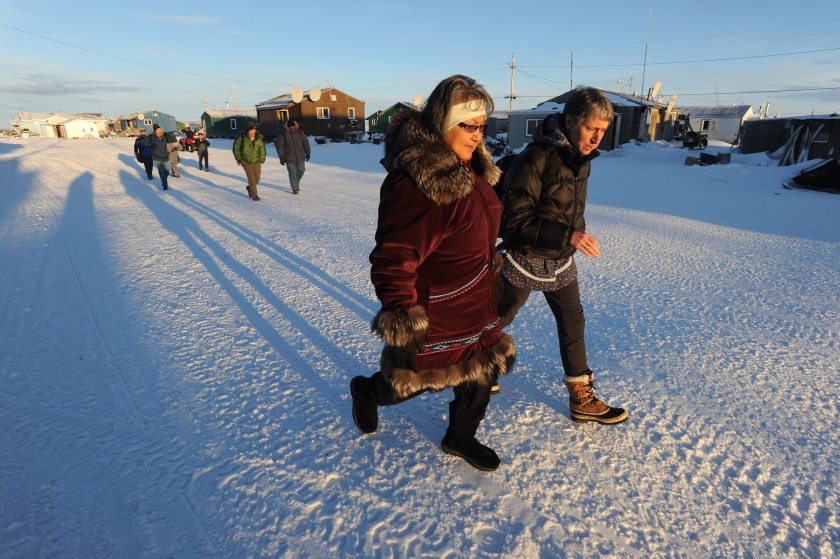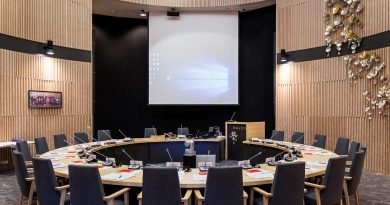U.S. interior secretary vows to work on solutions for climate-threatened Alaska village

KIVALINA — In a whirlwind visit to Northwest Alaska on an unseasonably warm day, U.S. Interior Secretary Sally Jewell on Monday told residents of this climate-threatened village that she would work with them on their relocation efforts.
Jewell is in the Arctic region at the invitation of the Alaska Federation of Natives. The state’s most powerful Native organization had organized a retreat in the hub city of Kotzebue for its 37-member board and wanted Jewell to address climate change and other issues affecting Alaska Natives in the Far North.
On a side trip to Kivalina before a full day of meetings Tuesday, Jewell and her entourage of federal officials flew over sections of the frozen-white Chukchi Sea that had opened up like a flowing river – strings of seals sometimes lining the edges. The open leads are known to happen in winter, though residents said they’re sometimes more extensive than they should be in February.
What is unusual is the steady warmth and shorter seasons that seem to be happening with unrelenting frequency, residents said. They told Jewell about increased melting and changes in animal behavior and also the increasing difficulty of keeping wild meat from spoiling in ice cellars.
Jewell saw a village of 400 clinging to a barrier island, with some of the homes just feet from the Chukchi Sea. Residents said the barrier island has shrunk in recent years – leaving little free land — as waves have battered away sections of beach.
“The land is eroding and getting smaller and smaller,” said Joe Swan, 79 and a lifetime resident of Kivalina.
Delegation tiptoes around resource development
Jewell isn’t the only top official attending the retreat. Gov. Bill Walker, nine state lawmakers and the Alaska congressional delegation are all in Kotzebue, planning to meet with Jewell. They’re angered by her recent decisions to limit oil and gas development in Alaska on federal lands and waters.
The state legislators planned to meet late Monday afternoon in what some viewed as a showdown between a federal government tiptoeing cautiously around resource development in Alaska and state officials worried about a massive deficit brought on by the plunge in oil prices and falling North Slope oil production.
Several of those lawmakers also flew into Kivalina on Monday to see the plight of the village and learn more about the need for a $60 million school to replace the overcrowded facility.
The state and federal groups crossed paths for only a short time because of scheduling conflicts for the tiny charter planes buzzing in and out of the village.
Relocation challenges
In a meeting with the Kivalina officials from the local tribe and city, Jewell saw plans for the village that included an evacuation road to a new school site on the mainland.
The Army Corps of Engineers estimated in 2009 that moving the village would cost $120 million.
She heard about how the federal government had chosen the vanishing village site decades ago, and about challenges to secure money to relocate the village to safe ground, she said.
Meantime, lawmakers toured the crowded school with tour-guide students in caribou-skin boots and dress ties.
While the state has committed to building the school on the mainland, there’s no certainty about who will build a causeway and 7-mile road to the proposed site. The road is expected to cost at least $40 million.
Community divisions
In a meeting in the school gym — where a large TV screen showed raw footage of waves slamming the Kivalina beach during past storms — legislators such as House Speaker Mike Chenault and Senate President Kevin Meyer heard division from the community about the new school site.
Some said the site was forced on the village in order to speed construction and is in a spot where wolves prowl and brutal winds barrel off the western foothills of the Brooks Range.
Joe Swan said it is too far from a village where people don’t even own cars or trucks. Are elders going to travel miles on snowmachines in a blizzard to pick up sick or misbehaving kids?
Build it, said elder Raymond Hawley: “If they want to relocate us, let them relocate us.”
He said there is no room to build new houses on the island. Also, if the village relocates, funds might also arrive for flush toilets and running water for the first time.
“That evacuation road and bridge better start pretty quick,” Hawley said. “I waited over 40 years for water and sewer. I think it’s time.”
Jewell arrived for the meeting at the school shortly after lawmakers began asking questions – such as how much the road might cost.
After an introduction, as locals arrived in fur-trimmed coats carrying fry-bread donuts, Jewell said she wanted to hear from elders about the changes to the land and how that has affected subsistence hunting – and where they see Kivalina in the future.
Working on long-term solution
Jewell said she would take their concerns and ideas back to Washington, D.C. “as we work with you on a long-term solution to the challenges you’re facing.”
She said she has grandchildren, too, and understands the village’s fears. “To have a school where you’re worried about their health and well-being with the storms is something that would be a constant worry to me if I was in your chairs,” she said.
Jewell told the crowd that in her meeting with the tribal government and the city, she tried to understand what role the state and federal government should play in a relocation effort.
She asked if the state lawmakers in the audience had anything to add.
Someone told her they’d already left, needing to catch planes.
“That was convenient,” Jewell said. “I’m kidding. Because I don’t know what’s the state’s responsibility is, what the federal government’s responsibility is. I understand the needs you have here, and that’s part of what we have to figure out.”
Later, during a press conference in Kotzebue in the glaring sun overlooking frozen Kotzebue Sound, Jewell was asked what it’s like to be in the Arctic where it was warmer, with temperatures in the 20s, than in Washington, D.C.
“It is a good backdrop for what I heard in Kivalina and what I’m hearing here,” she said. “It is crazy warm here.”
The need to learn more
She told journalists the trip was the first time she’d heard about Kivalina’s evacuation needs.
“I’ve got to do more research to figure out who provides what funding,” she said. “We’ve got a good story from being in Kivalina. We need to learn more and we’ll look into that as soon as I’m done.”
Sen. Lisa Murkowski, who arrived in Kotzebue on Monday afternoon, said coastal erosion in communities such as Kivalina is “absolutely real.”
“The real question is, ‘What do we do? How do we respond?’ Moving these villages to safer ground is incredibly expensive. It’s in the order of $100 to $120 million for a community of a couple hundred people,” Murkowski said.
She said that while the federal government has sent money oversees through the U.S. Global Climate Change Initiative, it has not focused the same efforts on mitigation and adaptation for Alaska’s coastline.
Murkowski said she hopes Jewell listens to “the people of the region who want to be in their homelands but want to be able to live there with some means of an economy.”
Related stories from around the North:
Canada: Canada showcases Nunavut designs at Venice Biennale, CBC News
Greenland: Greenland circumpolar conference looks at Arctic cities, CBC News
Sweden: The New Kiruna – A meeting place for past and future, Barents Observer
United States: Alaska military sites vulnerable to climate change, Alaska Dispatch



